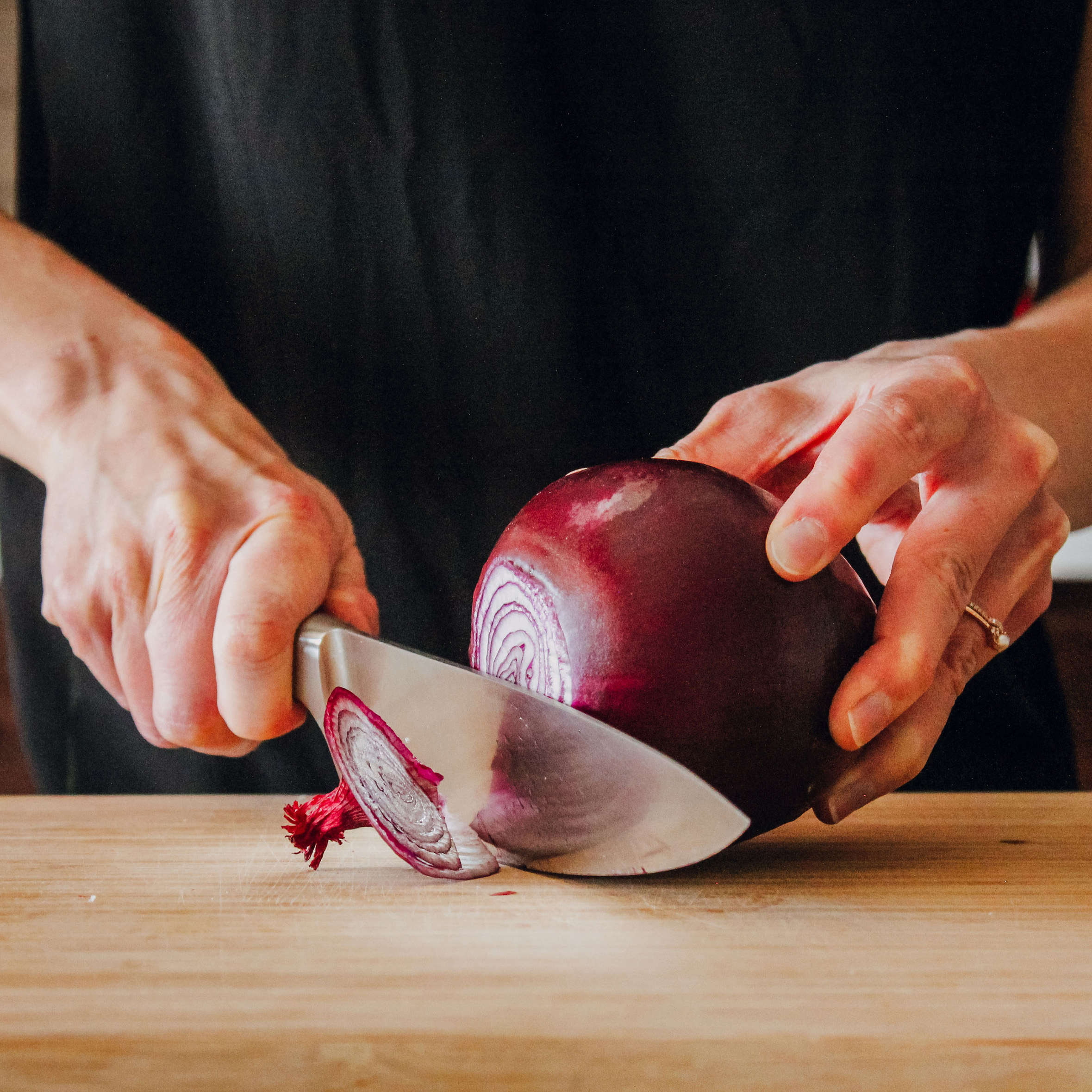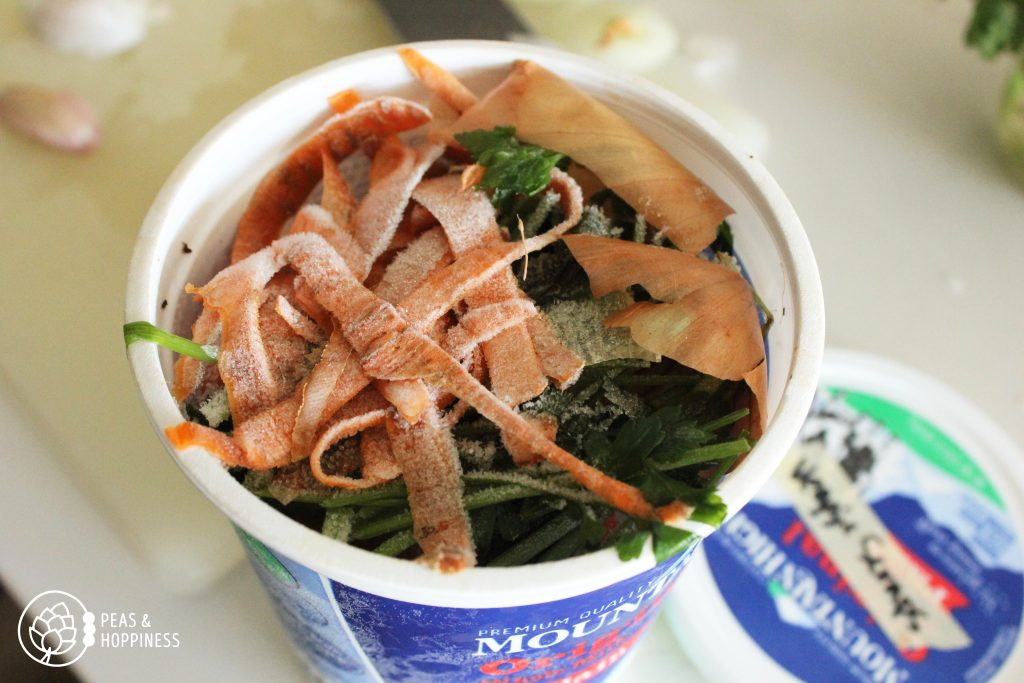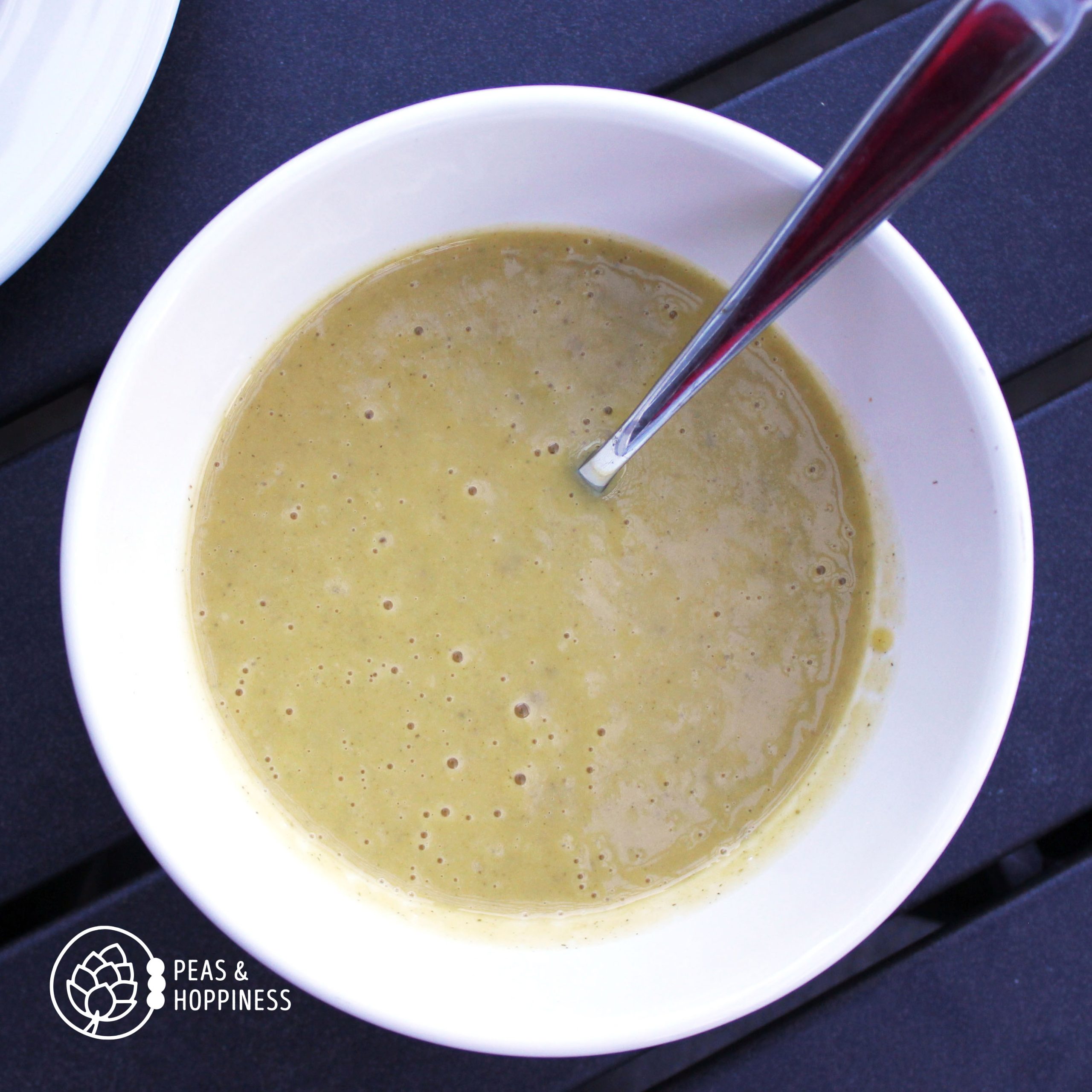Save money and reduce food waste with this easy recipe for budget-friendly homemade vegetable broth or stock using leftover veggie scraps – with options for slow-cooker and Instant Pot.
 Soup season is upon us! One of the easiest ways to add more flavor to soups is to use vegetable broth in place of water.
Soup season is upon us! One of the easiest ways to add more flavor to soups is to use vegetable broth in place of water.
Although you can buy vegetable broth in the store, making it yourself is really easy and so much tastier. Plus, it’s a great way to use up parts of veggies you would otherwise throw away!
Yes, you can use the peels of carrots and the ends of celery which you don’t normally eat. These have lots of flavor you don’t want to miss out on. The next time you’re prepping vegetables, follow this easy process to make your homemade vegetable broth or stock.
Save & Freeze Vegetable Scraps to Make your Homemade Veggie Broth
As you prep vegetables for meals you’re making, collect the scraps and freeze them. I like to use upcycled yogurt or cottage cheese containers, which are the perfect shape and size for adding vegetables.
In terms of seasonings to add, make sure to avoid adding salt to your homemade vegetable broth so that you can easily use it in place of water. Otherwise, you’ll need to omit salt in the recipe and add salt to taste – to avoid a potentially over-salted mess!
Which Vegetables to Save for Stock or Broth
Some vegetables naturally lend themselves to creating a delicious broth. These veggies listed below will give your broth a hint of sweetness and lots of flavor!
- Onion & garlic peels
- Carrot & parsnip tops & peels
- Celery ends & tops
- Potato peels (will make the broth starchy; avoid adding too many)
- Tomato stems
- Butternut squash peels (these are fairly mild in flavor, so don’t include too many)
- Jalapeno or other hot pepper stems (warning: can make the broth spicy! Avoid using the inside white pith of the pepper, which can become bitter)
- Zucchini and summer squash ends & peels
- Mushroom stems (although these are totally edible, so I always include the stems in my recipes… but if you don’t, save them to add to your vegetable stock)
- Veggies which are almost – but not quite – going bad: limp celery, flimsy carrots – just make sure to avoid those with mold
- Fresh or dried herbs you love: parsley, thyme, rosemary, oregano, basil – just remember the flavors will concentrate, so avoid using too many. The stems (which you otherwise might toss) are perfect for veggie stock!

Which Vegetables NOT to Use to Make Stock or Broth
Some vegetables will make your broth taste bitter, too spicy, or otherwise bad. Avoid using these veggies in your homemade broth:
- Moldy food or food which is going bad: at best, this will make the broth taste bad. At worst, it could make you sick!
- Peels with dirt: although part of the process is to strain the broth, small particles like sand or dirt will slip through. If you’re unable to scrub the dirt from the vegetables, leave these out of your broth to avoid a sandy crunch.
- Cruciferous veggies: Brussels sprouts, broccoli, cauliflower, cabbage, or kale – these can make your broth become bitter
- Green bell peppers (and possibly other colors of peppers, as well): these can make your broth become bitter. Especially avoid using the inside white pith of the pepper.
- Fresh cilantro: some people have a gene which causes cilantro to taste like soap. For this reason, I’d recommend to leave it out of your broth and instead add cilantro to taste when making the recipe
- Salt: this isn’t a vegetable (obviously), but I recommend to NOT add salt to your homemade vegetable broth and instead to add salt to taste when using this in recipes. This will give you more versatility and the option to use your broth in place of water in recipes for additional flavor.
How to Enhance the Flavor of Homemade Vegetable Broth
Sauté the vegetable scraps in oil before simmering making the broth to enhance the flavor. This step is optional, but I recommend it if you can!
To do so, heat a large pot or sauté pan over medium-high heat. Once hot, add olive oil, then add the veggie scraps you’ve been saving.
Note: you don’t need to thaw frozen scraps before using them; simply throw them in frozen and stir until they start to cook down.
If you’d like, add any extra herbs or spices at this step. Cooking spices in oil before adding water helps to release their flavor in a process called “blooming” the spice. This also helps to evenly distribute the flavor throughout the dish.

How to Make Homemade Vegetable Broth from Veggie Scraps
To make homemade vegetable broth, simmer vegetable scraps in water. If desired, cook the veggie scraps in water longer to evaporate liquid and concentrate the broth to make vegetable stock.
Choose from different methods to simmer your broth low and slow for many hours:
Stovetop Method to Make Vegetable Broth
For stovetop method, use a large pot to sauté vegetables. Once scraps start to brown, simply add enough water to at least cover the vegetables. Add more water if planning to cook a longer time to account for evaporation.
Slow-cooker Method to Make Vegetable Broth
If desired, sauté vegetables in a skillet or sauté pan, then add water to the pan and deglaze the pan by stirring to scrape off and incorporate any browned bits. Transfer vegetable scraps to a large slow cooker and add enough water to cover the vegetables. Cook on low for up to 12 hours, adding more water if needed to account for evaporation.
Note: skip the step of sauteing if desired. This adds extra prep time, but also adds more flavor to the broth.
Pressure Cooker Method to Make Vegetable Broth
Use an Instant Pot to sauté the vegetable scraps, then add water directly to the pot, taking care you don’t add more than the max level of the pot. Use the manual setting on high pressure and set for 30 minutes. Once finished, allow to release pressure using the slow natural release.

How to Store Homemade Vegetable Broth
Once the vegetables have been simmering for several hours, remove the broth from the heat. Strain the liquid through a fine mesh strainer to collect the broth. Discard or compost the vegetable scraps.
Allow the broth to cool and transfer to reusable plastic containers or glass mason jars. If using glass, leave space at the top of the jar and to fill to the point below which the jar starts to curve inward to prevent the jar from cracking in the freezer due to expansion of the liquid as it freezes.
Refrigerate broth overnight in the jars to chill completely before transferring to the freezer.
Always label your jars with the contents and date so you don’t have to wonder what the brownish liquid-type substance is when you’re rummaging in your freezer six months from now.
Broth will lose a small amount of quality over time but is good in the freezer up to a year.
When thawing in the microwave, always use the “defrost” option. Heating from frozen can sometimes cause liquid to boil in the bottom before the top has thawed and cause the jar to burst from the pressure (yikes!).
How to Use Homemade Vegetable Broth
 Use the unsalted vegetable broth in place of water in almost any recipe to enhance the flavor. Casseroles, soups, and stews are all great ways to use the broth.
Use the unsalted vegetable broth in place of water in almost any recipe to enhance the flavor. Casseroles, soups, and stews are all great ways to use the broth.
Here are a few of my favorite recipes which I love to use the broth. Save or Pin these recipes for later!
- Creamy Butternut Squash Soup
- Curried Red Lentils with Fried Cauliflower and Peanuts
- Lentil Tater Tot Casserole
For more ways to save money and prevent food waste follow this easy 3-step process for meal planning. You’ll be amazed at how much time and money you can save by spending just 15 minutes a week making a plan!
If you try this recipe, leave a comment and let me know what you think. You can also share your success on social media – tag me @peasandhoppiness on Instagram or Facebook.
I hope you and your family enjoy this delicious homemade vegetable broth as much as we do!
Happy soup season,
Dietitian Ann
Know the Best Vegetables for Each Season
Snow on the ground? No problem! Download this free Seasonal Vegetable Guide to know which veggies are best for each season of the year.
